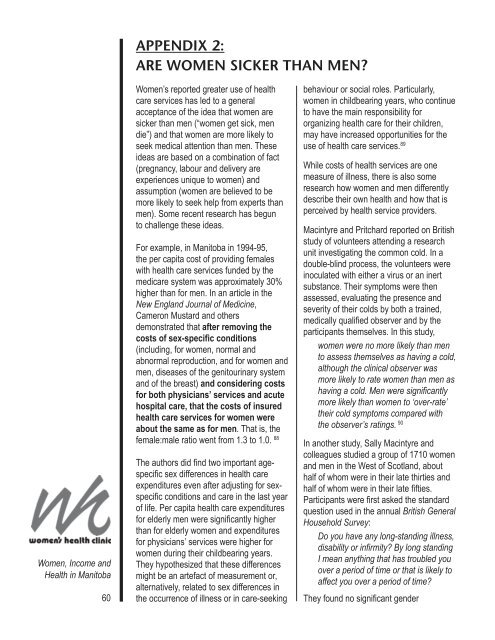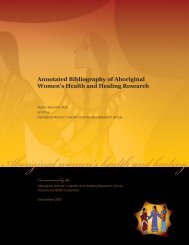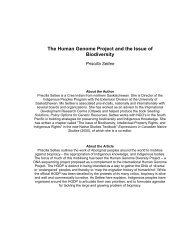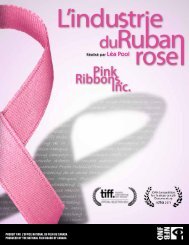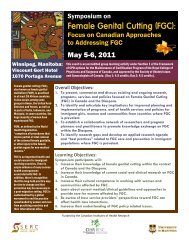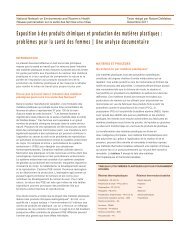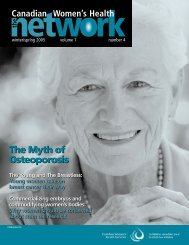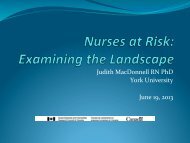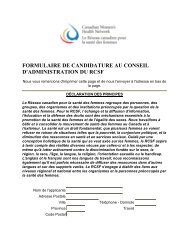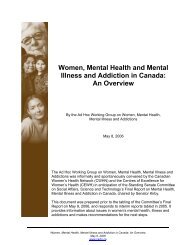APPENDIX 2:ARE WOMEN SICKER THAN MEN?Women, Income and<strong>Health</strong> in Manitoba60Women’s reported greater use of healthcare services has led to a generalacceptance of the idea that women aresicker than men (“women get sick, mendie”) and that women are more likely toseek medical attention than men. Theseideas are based on a combination of fact(pregnancy, labour and delivery areexperiences unique to women) andassumption (women are believed to bemore likely to seek help from experts thanmen). Some recent research has begunto challenge these ideas.For example, in Manitoba in 1994-95,the per capita cost of providing femaleswith health care services funded by themedicare system was approximately 30%higher than for men. In an article in theNew England Journal of Medicine,Cameron Mustard and othersdemonstrated that after removing thecosts of sex-specific conditions(including, for women, normal andabnormal reproduction, and for women andmen, diseases of the genitourinary systemand of the breast) and considering costsfor both physicians’ services and acutehospital care, that the costs of insuredhealth care services for women wereabout the same as for men. That is, thefemale:male ratio went from 1.3 to 1.0. 88The authors did find two important agespecificsex differences in health careexpenditures even after adjusting for sexspecificconditions and care in the last yearof life. Per capita health care expendituresfor elderly men were significantly higherthan for elderly women and expendituresfor physicians’ services were higher forwomen during their childbearing years.They hypothesized that these differencesmight be an artefact of measurement or,alternatively, related to sex differences inthe occurrence of illness or in care-seekingbehaviour or social roles. Particularly,women in childbearing years, who continueto have the main responsibility fororganizing health care for their children,may have increased opportunities for theuse of health care services. 89While costs of health services are onemeasure of illness, t<strong>here</strong> is also someresearch how women and men differentlydescribe their own health and how that isperceived by health service providers.Macintyre and Pritchard reported on Britishstudy of volunteers attending a researchunit investigating the common cold. In adouble-blind process, the volunteers wereinoculated with either a virus or an inertsubstance. Their symptoms were thenassessed, evaluating the presence andseverity of their colds by both a trained,medically qualified observer and by theparticipants themselves. In this study,women were no more likely than mento assess themselves as having a cold,although the clinical observer wasmore likely to rate women than men ashaving a cold. Men were significantlymore likely than women to ‘over-rate’their cold symptoms compared withthe observer’s ratings. 90In another study, Sally Macintyre andcolleagues studied a group of 1710 womenand men in the West of Scotland, abouthalf of whom were in their late thirties andhalf of whom were in their late fifties.Participants were first asked the standardquestion used in the annual British GeneralHousehold Survey:Do you have any long-standing illness,disability or infirmity? By long standingI mean anything that has troubled youover a period of time or that is likely toaffect you over a period of time?They found no significant gender
Women, Income and<strong>Health</strong> in Manitoba61differences in response to this question. 91In this study then, women were not morelikely than men to report illness. But whathappened when respondents were probedabout the meaning of their responseswas interesting.The researchers prompted the participantswith three more questions about their selfperceivedhealth – about other healthconditions which seriously affected theirhealth, about their mental health and finallyby showing cards with lists of conditions onthem. The number of conditions reportedincreased for both men and women, butthe increases were greater for women thanfor men, suggesting that women weremore stoic than men, reporting fewerof their illnesses in response to astandard question. 92In Denton and Walters’ paper analyzingdata from the 1994 National Population<strong>Health</strong> Survey, they found that morewomen (12.7%) than men (10.0%)described their own health as “fair” or“poor”. Men also had higher scores offunctional health than women. 93 However,these data were presented in a way whichdid not control for age and socio-economicstatus. Whether controlling for thesevariables would make a difference in thisparticular study is not known.In Sara Arber and Helen Cooper’s analysisof three years of British General HouseholdSurvey data for older people, they initiallyfound a similar pattern. However, theyconcluded that:...the original gender difference inself-assessed health in which olderwomen are more likely to report poorself-assessed health is mainlybecause of their older age onaverage than men, and becausethey occupied lower positions thanmen in the class structure duringtheir working life. When olderwomen’s greater likelihood of experiencingfunctional disabilities isincluded in the model, this results ina reversal of the gender difference,so that older womenare shown to be less likely to reportpoor health than older men. 94Arber and Cooper found that older womenwere less likely than older men to describetheir own health as poor, suggesting, onthe surface, that they were in better healththan the men in the survey. However, wheninformation about functional impairmentwas measured (using six tasks of dailyliving), women’s health status wassignificantly worse than that of men.They concluded that:This research supports the finding ofothers studies that t<strong>here</strong> is littlegender difference in self-assessedhealth among older people in themid-1990s. However, the ‘newparadox’ that older women have amore positive self-assessment oftheir health status than men, onceage, class, income and their greaterlevel of functional disability aretaken into account, requiresfurther explanation. 95What conclusions can be drawn fromthis research? Assumptions based onstereotypes about the health of women,about their behaviour when faced withill health and about their attitudestowards their own health and illness,may be wrong. When policies andprograms are based on thesestereotypes, problems may result.The dangers of such stereotyping in thediagnosis and treatment of women wasreported recently in the British popularpress. The British Observer published anarticle in May, 2000, entitled Moaning menpush women to the back of the healthqueue. The article stated in part:…it is still commonly assumed bydoctors, surgeons, nurses and healthworkers that women complain moreoften about illness than men.This ‘tendency’ is blamed on the fact
- Page 1 and 2:
WOMEN, INCOME ANDHEALTH IN MANITOBA
- Page 3 and 4:
TABLE OF CONTENTSPageA. EXECUTIVE S
- Page 5 and 6:
EXECUTIVE SUMMARYTHE LINK between p
- Page 7 and 8:
Women, Income andHealth in Manitoba
- Page 9 and 10: B. INTRODUCTIONMuch work has been d
- Page 11 and 12: Consistent with the majority of soc
- Page 13 and 14: Health and Well-Being of Children i
- Page 15 and 16: Women, Income andHealth in Manitoba
- Page 17 and 18: members of different visible minori
- Page 19 and 20: Women, Income andHealth in Manitoba
- Page 21 and 22: 3. How has the connection between i
- Page 23 and 24: E. INCOME AND THE HEALTH OF WOMEN -
- Page 25 and 26: Women, Income andHealth in Manitoba
- Page 27 and 28: majority of British households,rega
- Page 29 and 30: Women, Income andHealth in Manitoba
- Page 31 and 32: The following chart, based on a cha
- Page 33 and 34: marsh potatoes, berries, etc. As a
- Page 35 and 36: opportunities for women may beone o
- Page 37 and 38: 2. Manitoba Data - Income and Healt
- Page 39 and 40: CHART 3HEALTH CARE EXPENDITURES ON
- Page 41 and 42: 3. What Does This Mean?As in other
- Page 43 and 44: procedures. It is noteworthy that t
- Page 45 and 46: 2. The Commonwealth Secretariat -Mo
- Page 47 and 48: Women, Income andHealth in Manitoba
- Page 49 and 50: H. MAKING PUBLIC POLICY HEALTHIER F
- Page 51 and 52: against women and its consequences
- Page 53 and 54: 3.3 CHILD TAX BENEFITThe Government
- Page 55 and 56: Household Basic Rent Rent Including
- Page 57 and 58: If RHAs are open to suchcollaborati
- Page 59: APPENDIX 1:SUGGESTIONS FOR FUTURE R
- Page 63 and 64: APPENDIX 3:HEALTH SERVICE UTILIZATI
- Page 65 and 66: APPENDIX 4:INTERVIEWS WITH ABORIGIN
- Page 67 and 68: Women, Income andHealth in Manitoba
- Page 69 and 70: Women, Income andHealth in Manitoba
- Page 71 and 72: Women, Income andHealth in Manitoba
- Page 73 and 74: ELEMENT #11GENDER SENSITIVE TRAININ
- Page 75 and 76: Women, Income andHealth in Manitoba
- Page 77 and 78: ENDNOTES1. Sarlo, Christopher, “P
- Page 79 and 80: ENDNOTES (continued)45. Arber, Sara
- Page 81 and 82: ENDNOTES (continued)88. Mustard, Ca
- Page 83 and 84: REFERENCES (continued)Clarke, H.F.
- Page 85 and 86: REFERENCES (continued)Macintyre, Sa
- Page 87 and 88: REFERENCES (continued)Vancouver/Ric


